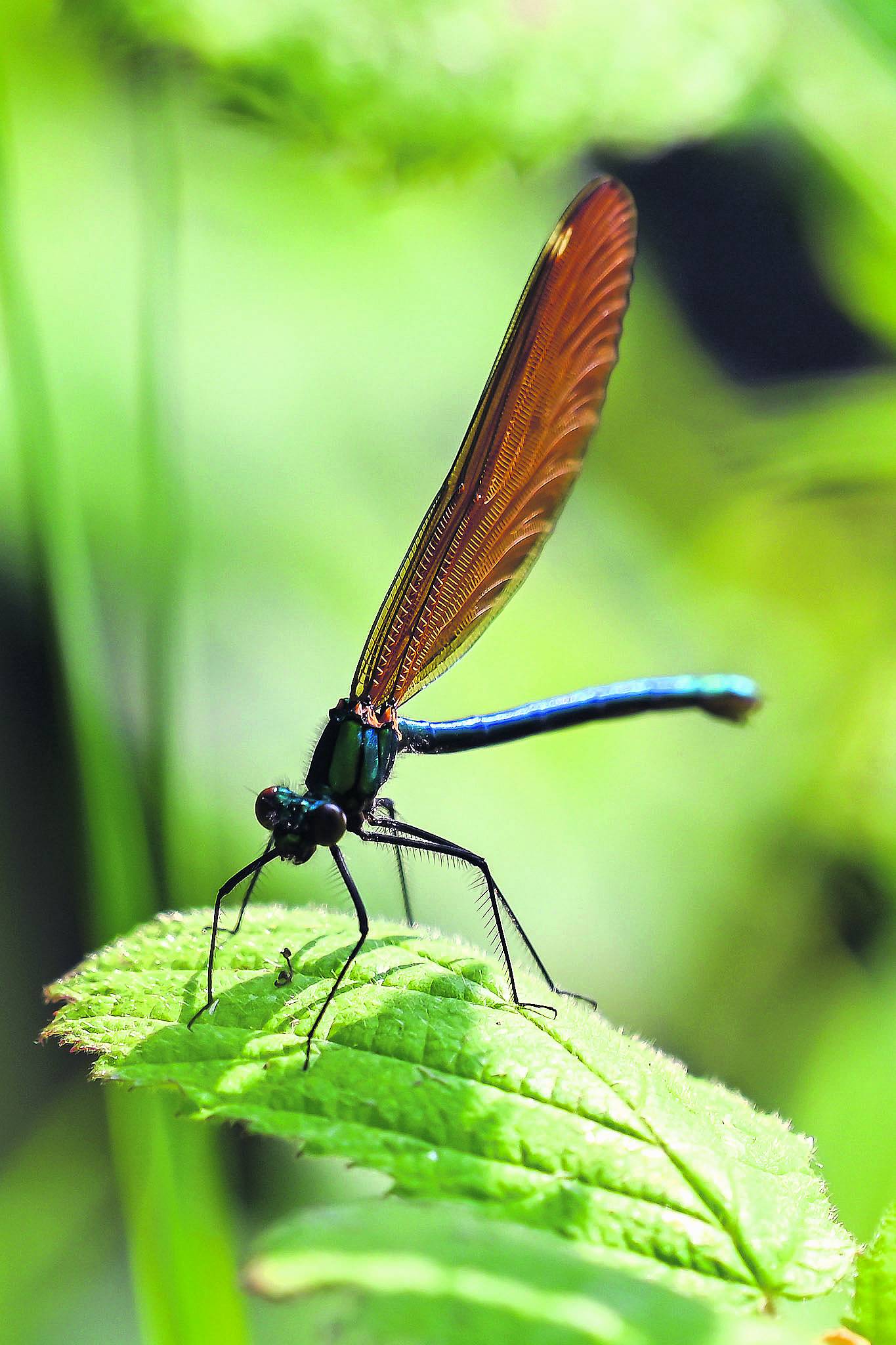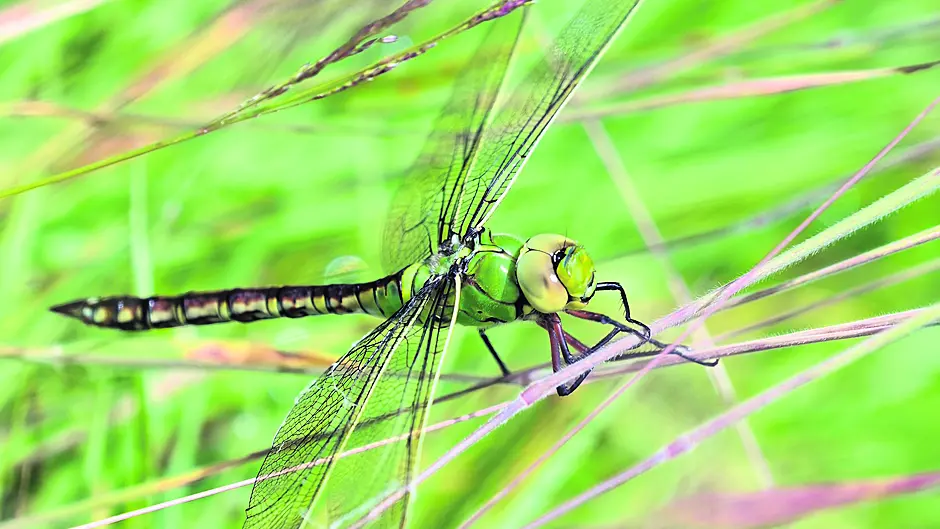WITH warmer weather and the schools having closed for the holidays, it feels like summer is fully here and nothing says summer more than the sight of dragonflies.
Both dragonflies and damselflies are associated with freshwater so the best places to start to look for them are along the edges of ponds, lakes, rivers, or bogs. That said, dragonflies are strong fliers and are often found quite far from water. We have spotted both dragonflies and damselflies all over West Cork, in locations such as Shepperton
Lakes, beside the Ilen and Bandon rivers, along the Joe Walsh walkway in Clonakilty by Gullane Lake and even by garden ponds. They really are widespread once you take the time to look for them.
Even for the most reluctant of insect lovers, these charismatic creatures must surely have appeal with their bright iridescent colouring, significant size and their appearance like miniature helicopters as they zip past.
Native species
Firstly, what is the difference between dragonflies and damselflies? They are both flying insects in the order Odonata, but they are in different suborders and vary slightly in appearance. Damselflies are smaller, keep their wings folded back over their bodies when at rest and have widely separated eyes. Dragonflies are much larger, hold their wings out to the side at rest, often at right angles, and have larger eyes that meet in the middle.
Ireland has 14 resident dragonfly species, 11 resident damselfly species, and five vagrant or migrant species, giving a total of 30 different species that you have a chance to see.
That is a manageable number for anyone trying to spot them all, but some are rarer than others. Migrants are more commonly spotted in the south-east, where they arrive from Britain or mainland Europe.
The Irish Damselfly
Many species have delightful names such as the beautiful demoiselle, azure damselfly, four-spotted chaser, and ruddy darter. More simplistic in name but with a very mysterious backstory is the Irish damselfly (Coenagrion lunulatum). This species is scarce in Ireland and has a limited distribution, confined to the northern half in low nutrient wetlands, lakes, fens, and bogs. Strangely, while Ireland has less dragonfly and damselfly species overall compared to Britain, this species is a rare exception and does not occur there. Work is ongoing to compare the DNA of the Irish population to other populations in Europe to see where this native species originated from and whether it is a unique subpopulation.
 A beautiful demoiselle. Damselflies are smaller than dragonflies, keep their wings folded back over their bodies when at rest, and have widely separated eyes. (Photo: Nick Haigh)
A beautiful demoiselle. Damselflies are smaller than dragonflies, keep their wings folded back over their bodies when at rest, and have widely separated eyes. (Photo: Nick Haigh)Worryingly, the Irish damselfly population is decreasing here as this species is sensitive to pollution, particularly run-off from agriculture such as nitrates and phosphates, and is threatened by ongoing habitat loss and climate change. It is listed as vulnerable in Ireland on the all-Ireland Red List. While experts are not sure why it is in Ireland at all, this is a rare species and one we should try to look after.
Cycle of life
Eggs are laid on underwater vegetation and develop into a water dwelling nymph, also called a larva. Depending on species, the nymph spends from weeks up to several years under water, undergoing a series of moults as they grow. Unlike moths and butterflies, there is no pupal stage and when ready the nymph crawls up out of the water and undergoes its final moult where the ‘skin’ splits to release the adult insect.
Newly-emerged adults are called tenerals and are very delicate and vulnerable. They are not able to fly immediately as it takes a few hours for blood to be pumped into their wings to give them their final shape and strength.
Adults may live for up to four or five months but early mortality is high due to weather and predation. Dragonflies and damselflies are valuable in the food chain at both the adult and the larval stages. Birds, frogs, and spiders prey on the adults and aquatic birds such as the dipper and kingfisher, fish, and frogs prey on the larvae.
Fearsome predators
Dragonflies and damselflies do not bite or sting humans but they are fearsome predators, both as aquatic nymphs and as flying adults. Underwater nymphs feed on aquatic invertebrates and even small fish and tadpoles. As adults they hunt other flying insects while on the wing. With excellent eyesight and a top flying speed in larger species of up to 48 km/hr, smaller insects do not stand much of a chance. Dragonflies have four wings which can move independently of each other, affording them superior flying skills compared to other insects, with the ability to hover and even fly backwards.
Monitoring
On June 24th, I enjoyed a dragonfly and damselfly identification course held by the National Biodiversity Data Centre (NBDC) in the Independence Museum in Kilmurry, after which there was a field trip to seek and identify these insects at The Gearagh. So now, besides purely enjoying the sight of them flying past, I should in theory be able to identify them on sight. The course was part of the Dragonfly Ireland 2019–2024 initiative which is an all-Ireland cooperation between the NBDC in Ireland and the Centre for Environmental Data and Recording in Northern Ireland. As well as encouraging and training citizens to record sightings, they will use the data collected to provide information about the effects of climate change and whether the presence or absence of dragonflies and damselflies can be linked to water quality. The information collected over the four years will inform an Atlas of Dragonflies and Damselflies with an updated redlist of the species at risk.
Dragonflies and damselflies can be spotted from early Spring until well into October, so you still have plenty of time to get involved by spotting and recording your sightings. To quote the wildlife writer Simon Barnes, ‘If you are old and you wish to be young again, if only for a moment, try and identify a dragonfly.’
DRAGONFLY AND DAMSELFLY FACTS
• Fossil records show they existed over 250 million years ago and once lived alongside dinosaurs.
• Dragonflies have excellent vision of nearly 360 degrees and each eye has several thousand lenses.
• Males are more brightly coloured, with females tending to be less vibrant.
• Dragonflies have a 95% success rate for catching prey, which is the highest rate in the animal kingdom.
• The average time dragonflies spend as underwater larva is 1-2 years, but the golden-ringed dragonfly spends up to 5 years.
• Species records show changing distributions due to climate change; one example is the emperor dragonfly which is spreading northward from its previous confines in the south.
• Ann Haigh MVB MSc MRCVS is a Skibbereen resident, a mum of two, and a veterinarian with a master’s degree in wildlife and conservation and she is passionate about biodioversity and
nature.








